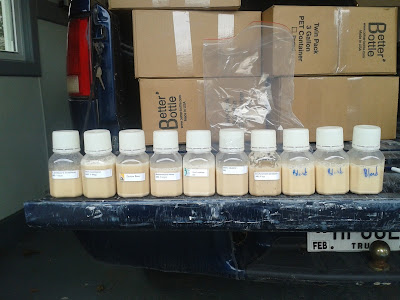Over the weekend I met with the guys at Leidel's Orchard to do our
brett cider experiment. The yeast arrived safely, the juice was ready, and they had purchased all the carboys/bungs/airlocks needed.
 |
| Wild yeast strains from East Coast Yeast |
After we sanitized everything, we filled each carboy with 3 gallons of juice. To ensure that our pitched yeast would be the source of 100% of the fermentation, the juice had been pasteurized at the pack house and then shipped to us frozen. While we were waiting for the juice to warm up to room temperature, I dissolved 5 ounces of maltodextrin into some juice, and then added it to the juice already in carboy #11. (
batch list here)
 |
| 11 wild cider batches |
Later that evening the yeast was added. The only yeast strain that didn't come from East Coast Yeast was the B. Brux, which came from Wyeast. 24 hours after pitching every carboy except #5 (Brux) was in active fermentation. #3 (Nanus), #7 (Fantome), and the brett blend batches were the most active. Giving them a slight shake would almost blow out all the star-san solution in the airlock!
They will be left in that room, which is a steady 60 degrees, for the next month or two. Unfortunately, the orchard is 2.5 hours from where I live, so I won't be able to check on it regularly, or take weekly gravity readings. The goal of this experiment is primarily to see the flavor/aroma contribution of each of these strains and to find which ones we like in cider.



6 comments:
very exciting project! i've been wondering about brett in cider for some time. a while back i made a brown ale-cider hybrid with wyeast's trappist blend (sacc + orval's b. brux). it came out really nice, but i'm excited to see what 100% brett fermentations will do. cheers!
I cant wait for your results. My biggest concern/interest with this is the mouth feel. Are you hoping to get this from tannins in the apples? Or maybe you will correct this with the apple blend come this fall, or barrel aging. Hopefully it turns out, being from St Paul I will be checking out the orchard this fall just because of this! Also would love some of Al's yeast if you are harvesting any after fermentation...
@Mud Duck - This is a test to see the impact each yeast strain has on the cider's flavor and aroma. For that reason the cider we used is a fairly neutral blend and not high in tannins. Blending apple varieties is a big part of creating a well rounded flavor profile in cider, and so we would incorporate that step with commercial batches.
As for mouth feel, the purpose of doing the batch with the maltodextrin addition is to see the impact on mouth feel. I'm not sure what the final gravity will be for these brett fermented ciders, but its possible that maltodextrin is needed to add a little body.
Interesting experiment. I'm planning to do a Brett cider, and I'm considering whether or not I'll pitch some lacto in there as well for an MLF. If I'm not mistaken, lacto will turn the apple's malic acid into lactic acid, and Brett will turn lactic acid into some sort of fruity ester. Pineapple, I think?
So, I've really got my eye on batch #10, the Brett with the oenococcus.
@Anon - As I understand it, lacto will do a MLF, but I don't believe Brett turns lactic acid into fruity esters. I think Brett eats other compounds such as diacetyl to create it's esters, and which esters it creates is very strain dependent. Look at Chad Yakobson's Brettanomyces Project. I'm sure the answer is in there somewhere.
How can i wash a carboy ?
Post a Comment